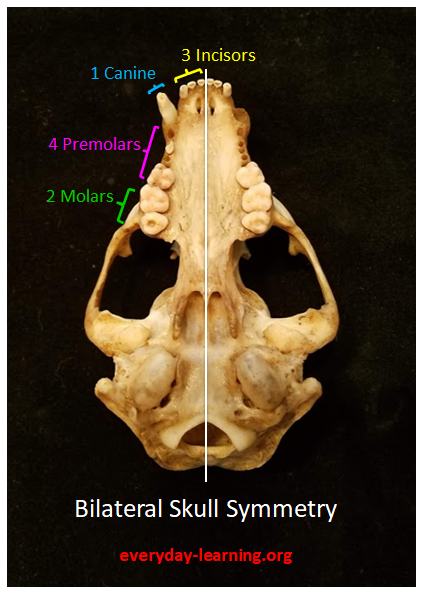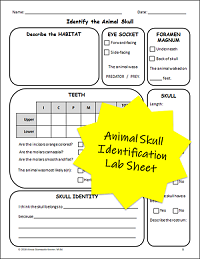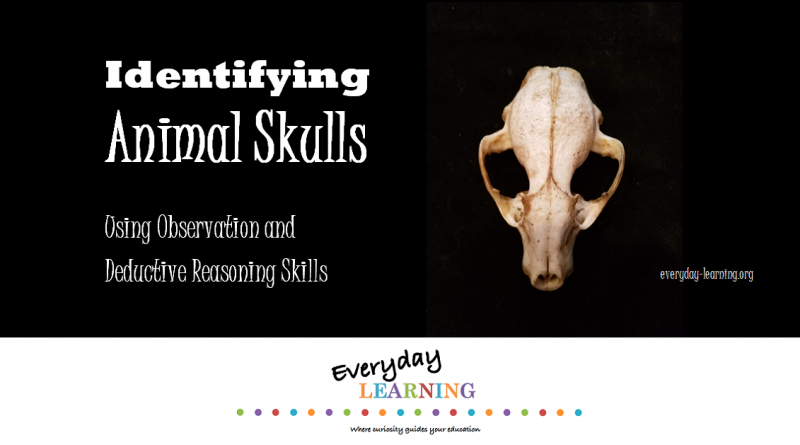Discover This: Skull Identification

I was out walking my dog the other day and what do my wandering eyes catch a glimpse of? An animal skull identification science lesson, sitting in the middle of a baseball diamond.
I have no idea how such a dirty, but otherwise well preserved animal skull, found itself in the middle of a well-groomed playing field, But, not one to pass up a science mystery, we opted for the opportunistic hands-on learning lab to try to figure out what kind of animal we had stumbled upon.
Initial Observations
Now, I’m not a scientist, but I am a fan of the power of deduction. I know enough basic animal science facts that I can ask a bunch of leading questions to start the process of elimination. By narrowing down the field of choices for possible animal-skull matches, an Internet search will yield more accurate (and satisfying) animal skull identification results.
Habitat
I live in a Mid-Atlantic surburb. My community is full of housing developments, but we’re also surrounded by a lot of farms, wooded areas, and even an old mine. It’s unlikely that a cow, goat, or chicken would wander over to where we found our skull specimen. We are, however, far enough from a major city that deer and fox wander our neighborhood. At the same time, we’re outside the bobcat, beaver, and black bear’s habitat range for our state. We’ve seen opossum, rabbits, raccoons, and groundhogs throughout the years. We even smelled a skunk in the neighborhood, once. But, we know that badgers, otters, and wild boar don’t live anywhere near us. Brainstorming about the fauna that live in our biome gets us thinking critically about animal-skull match-up options.
Horns and Beaks
Sometimes, a missing skull feature can be a good place to start with narrowing down an animal skull identification. The absence of a beak clearly takes out all birds from our list of match-up options. But, what conclusions can you make about a skull not having antlers? The most obvious fact would be that the animal is not male. Well, that’s true unless you live in an area with caribou and wildebeests or certain breeds of cows, where females also grow horns and antlers. Since those animal exceptions don’t live in our state, we can rule them and deer off our list of possible animal-skull match-ups.

Skull Size
Measuring the length and the width of the skull can help to eliminate a number of animal families. The skull I found measured about 15cm (or 5.25in) long. We can eliminate some obvious animals from our list of possible options, based on larger and smaller species. For example, a 30cm (~ one foot) long skull might belong to a horse and a 3cm long skull might belong to a mole. Both these animals – and other animals of similar size, can be crossed off our list.
HINT: In case you don’t have a measuring tape handy, you can still estimate length. Generally speaking, 2.5cm equals 1 inch. A quarter (coin) equals about one inch. Check to see what part of your hand a quarter is equivalent to. On my hand, a quarter is about the size of my thumb nail.
Foramen Magnum
Foramen (pronounced: four-aye-men) is just a fancy science word for an opening in a bone. Skulls have any number of openings and they all have special names. Foramen Magnum refers to the hole where the spinal cord enters the skull. In humans and other bipedal (2-footed) animals, the Foramen Magnum can be found at the bottom of the skull. In quadrupeds (4-footed animals), the Foramen Magnum is closer to the back of the skull, allowing the head to be more horizontal with the body and spinal cord.
The Foramen Magnum for the skull I found is near the back, meaning my animal was a 4-footed critter.
Eye Socket
An animal’s eyes will either be pointed forward or off to the sides. The direction of the eyes can tell you if the animal was a predator or a prey.
Animals with forward facing eyes have better binocular vision. Binocular vision helps predators figure out depth and distance and how precise they need to be to pounce on an animal they’re hoping to eat for lunch.
Animals with eyes facing to the sides wind up having a wider range of vision, which helps the prey animals detect sneak attacks and other predatorial threats. Some animals, like antelope, have up to 360 degrees of vision without moving their heads.
HINT: Don’t let the Zygomatic Arch (or checkbone) confuse you about eye direction. Instead, look for the skull’s Postorbital Processes. A process is a little bump of a bone that grows off a larger bone. In some animals, the Postorbital Processes will join together in a full circle. In my skull, the Postorbital Processes barely curve around to make a half circle for where the eyes would have been – but it’s enough to let me know that my animal was likely a predator.
Sign Up to Receive More FREE Everyday Learning Ideas
Teeth
With the exception of anteaters, pangolins, and blue whales, mammals have teeth. Counting teeth can tell you a lot about the animal skull you are trying to identify.
Let’s review some animal teeth basics.
Most animals have 4 different types of teeth. Starting from the center of the mouth, the teeth include incisors, canines, premolars, and molars. HINT: Use the mnemonic I Can Play Maracas to remember the order of the types of teeth.
Incisors are located front and center of the mouth. They are used to cut and gnaw food. The incisors of some rodents, like beavers, constantly grow, so they may be more prominent in size than the other types of teeth. These incisors will also have a yellowish-orange color to them. Other animals, like deer, will only have incisors on their lower jaw.
Canines are the sharp, pointy teeth used for piercing and cutting into food. Carnivorous (meat-eating) animals may have canine teeth that extend below their lower jaw while their incisors are much smaller. Some herbivores (plant-eating animals), on the other hand, may have no canine teeth at all. Instead, their jaw will just have a flat surface between their incisors and the third type of teeth, premolars. In some animals, such as warthogs, walruses, and narwhals, canine teeth can grow into tusks. [Fun Fact: An elephant’s incisors grow into their tusk.]
 Premolars, also known as cheek teeth, are used to tear and grind food. In carnivores, premolars may lock together, like the teeth on some types of scissors. Unfortunately, it can be hard to know if a tooth is a premolar or a molar.
Premolars, also known as cheek teeth, are used to tear and grind food. In carnivores, premolars may lock together, like the teeth on some types of scissors. Unfortunately, it can be hard to know if a tooth is a premolar or a molar.
Molars are found in the back of the jaw and are used to grind food. In herbivores, molars tend to be flat and smooth from constant use. In carnivores, molars will still have ridges.
Before we count the number of teeth in the skull, we need to know a couple more basic facts. Animals have a mirror-image set of teeth on both sides of their mouth. This is useful to know, in case your animal skull is damaged. If your skull is missing teeth, you can use root holes to determine number of teeth, but you’ll need to know which teeth had 1, 2, or 3 roots.
When we count teeth, start with the middle of the front of the mouth and count towards the back. You’ll need to do a separate count for the upper and lower jaws, since the number and types of teeth can be different.
With my skull, the lower jaw was missing, but I still got good information from the upper jaw’s teeth. I know that my animal originally had 20 teeth in their upper jaw. Additionally, the canine teeth tell me for certain that my animal was a carnivore.
Assessing Our Findings
So, we’ve made a number of observations about the skull and we’ve eliminated a number of possible animals – but what kind of creature was our 4-legged, forward-looking, small-to-medium-sized, carnivorous predator? Can we make a positive animal skull identification?
Looking at the skull’s rostrum tells us our animal had a snout. Now, snouts can vary in shape across different groups of animals. Pigs, for instance, have a round, flat snout, whereas cats and bears have a more box-like snout. Snouts can also vary within an animal family. For example, a collie has a longer and thinner snout than a pit bull and a pug has virtually no snout at all.
Based on the length of the snout, I’m pretty confident our critter is not a house cat that got out and met its demise. But, we’re still not certain if the skull belongs to a dog or some wild animal, so now it’s time for some research before we make an animal skull identification.

We can also observe ridges along the top-side of the skull. The skull has a slight sagittal crest that runs lengthwise, a tell tale sign that the animal had some jaw-wrenching chewing strength. The skull also has an interesting V-shaped crest that runs from the front of the skull and helps to form the top postorbital processes. We’ll keep these observations in mind for later.
Just like in human CSI cases, dental records can help ID an anonymous victim. Even without a complete set of upper and lower jaws, we know the skull we found has 20 upper teeth. A quick Google search tells us that foxes, coyotes, dogs, shrews, moles, and raccoons also have 20 upper teeth – all following the 3-Incisor; 1-Canine; 4-Premolar; and 2-Molar pattern. We can immediately cross moles and shrews off the list because as prey animals, they have side-facing eyes, which is different from our skull.
Since it’s uncommon to hear of domestic dogs being attacked or left to die in our geographic area, we’re going to focus on the wildlife animals on our list first: Coyotes, foxes, and raccoons. Out of these 3 animals, coyotes are the largest in size and have the largest upper canine teeth. Our skull is on the smaller side, so we’re going to temporarily cross coyotes off the list.
Another quick Internet search of specific skulls brings up images of foxes and raccoons. Take a look at them and compare them to our found skull. Making a match is pretty easy, when you narrow down your field of choices.

Want More Animal Detective Fun?
 A walk in the woods does a body good, but you won’t always find animal skulls lying around. More importantly, there are some state and federal laws that prohibit you from collecting certain types of animal bones – so be knowledgeable or you might just be doing am impromptu unit study on law.
A walk in the woods does a body good, but you won’t always find animal skulls lying around. More importantly, there are some state and federal laws that prohibit you from collecting certain types of animal bones – so be knowledgeable or you might just be doing am impromptu unit study on law.
If you want to do your own CSI animal skull identification, check out your local nature center. You’ll often find a hands-on corner with locally found skull specimens. You can also take a look at the CSI Detective Notebook I put together to help keep your investigation on track. It includes (1) charts to help you more quickly analyze teeth data; and (2) a link to a digital portfolio of animal skull photos you can use as part of a lab.
Finally, I want to make a shout of thanks to the Maryland Department of Natural Resources for their time in confirming that our skull identification was correct.




